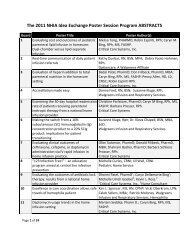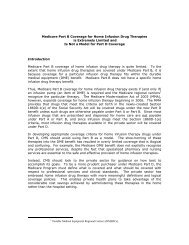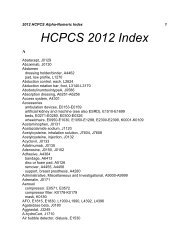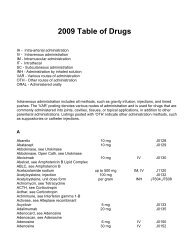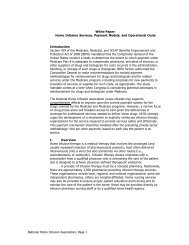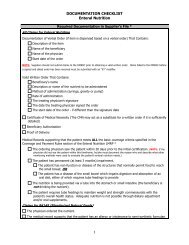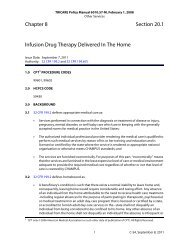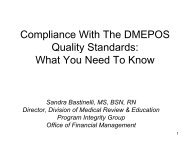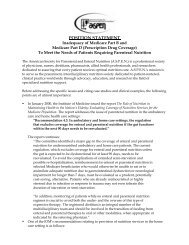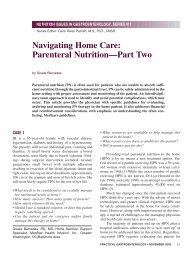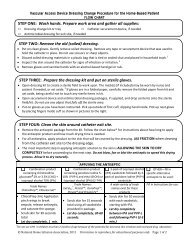traded, and whether it is a local or nati<strong>on</strong>al (i.e., multi-state) company.Overall, in FY 2011, 63 percent of <strong>Medicaid</strong> enrollees in MCOs were in plans that specialize in serving<strong>Medicaid</strong>. For-profit health plans accounted for a little over half of all <strong>Medicaid</strong> MCO enrollment (53percent). N<strong>on</strong>-publicly traded plans accounted for 58 percent of enrollment. <strong>Medicaid</strong> MCO enrollmentwas distributed about equally between nati<strong>on</strong>al and local plans (Figure 2). 8Appendix 3 provides state-by-state detail <strong>on</strong> MCO c<strong>on</strong>tracts, plan characteristics, and enrollment.Most states require <strong>Medicaid</strong> MCOs to be licensed as HMOs. Federal regulati<strong>on</strong>s generally requirethat <strong>Medicaid</strong> MCOs meet state solvency standards established for private HMOs, or be licensed orcertified by the state as a risk-bearing entity. 9 The vast majority of the 33 states resp<strong>on</strong>ding (of 36states with MCOs) reported that they require <strong>Medicaid</strong> MCOs to be licensed as HMOs or otherwiselicensed by the state insurance regulatory body, with specified, limited excepti<strong>on</strong>s. Two states(Ariz<strong>on</strong>a and Maryland) indicated that they have no insurance licensure requirements. Six statesreported that they allow exempti<strong>on</strong>s from state solvency requirements for <strong>Medicaid</strong> HMOs aspermitted by federal law, or for Provider Service Networks or Provider-Sp<strong>on</strong>sored Organizati<strong>on</strong>s(PSNs/PSOs), or Health Insuring Organizati<strong>on</strong>s (HIOs).More than a third of states with MCOs provide for an external appeals process for MCO enrollees.Fourteen states with MCOs (of 34 resp<strong>on</strong>ding) reported that, in additi<strong>on</strong> to the state fair hearingprocess required by federal regulati<strong>on</strong>s, they provide for an external appeals process for MCOenrollees. 10Outreach, marketing, and health plan selecti<strong>on</strong>Most states allow MCOs to c<strong>on</strong>duct permissible outreach and marketing activities. A total of 28 states(of 34 resp<strong>on</strong>ding) allow MCOs to c<strong>on</strong>duct outreach and marketing to <strong>Medicaid</strong> beneficiaries withinfederal rules, while six states do not allow plans to c<strong>on</strong>duct outreach or marketing.A substantial majority of states with MCOs 11 use enrollment brokers. Twenty-five states (of 35resp<strong>on</strong>ding) reported that they c<strong>on</strong>tract with a third-party enrollment broker to provide planinformati<strong>on</strong> to beneficiaries and assist them in choosing an MCO. Vendors listed by more than <strong>on</strong>e stateinclude Maximus (11 states), Automated Health Systems (five states), ACS (three states), and HPEnterprise Services (two states).<strong>State</strong>s’ auto-assignment algorithms typically reflect both beneficiary-based c<strong>on</strong>siderati<strong>on</strong>s and statepolicy objectives vis-à-vis MCOs. <strong>State</strong>s prefer that beneficiaries make a choice from the health plansoffered. However, <strong>Medicaid</strong> programs with any mandatory managed care must have a system forassigning <strong>Medicaid</strong> beneficiaries who do not select a plan within the required timeframe (although thestates allow these beneficiaries an opportunity to opt out of the assigned MCO and into a different <strong>on</strong>e).8 MCO enrollment informati<strong>on</strong> was not reported for Kansas or Nebraska.9 See 42 CFR §438.116. Excepti<strong>on</strong>s apply to federally qualified HMOs, public plans, plans that are (or are c<strong>on</strong>trolledby) <strong>on</strong>e or more federally qualified health centers, and those whose solvency is guaranteed by the state.10 The 14 states are California, Colorado, Delaware, DC, Florida, Hawaii, Illinois, Indiana, Michigan, New Jersey,Pennsylvania, Rhode Island, Washingt<strong>on</strong>, and West Virginia.11 Only states with MCOs were asked to report <strong>on</strong> enrollment broker arrangements.20 00
<strong>State</strong>s have “auto-assignment” algorithms for this purpose. The criteria in a state’s auto-assignmentalgorithm provide some indicati<strong>on</strong> of that state’s policy priorities. Two of the most comm<strong>on</strong> criteria –the MCO assignment of a related family member and geographic c<strong>on</strong>siderati<strong>on</strong>s – take into accountwhat might be most practical and desirable from the beneficiary’s perspective. However, states may alsodesign their algorithms to support programmatic objectives, such as balancing enrollment am<strong>on</strong>g plansand incentivizing improved plan performance. Figure 3 shows selected criteria used in auto-assignmentalgorithms and in how many states they are used.Figure 3Auto-Assignment Algorithm Factors(33 states resp<strong>on</strong>ding)Related family member assignmentGeographic c<strong>on</strong>siderati<strong>on</strong>sPrevious plan assignmentBalancing enrollment am<strong>on</strong>g plansPlan capacityPrior PCP in networkPlan quality performanceEncouraging entry of new plansPlan costNote: 36 states c<strong>on</strong>tract with MCOs.SOURCE: KCMU/HMA <str<strong>on</strong>g>Survey</str<strong>on</strong>g> of <strong>Medicaid</strong> <strong>Managed</strong> <strong>Care</strong>, September 2011.Number of states using factor:Auto-assignment rates appear to vary greatly. Autoassignmentrates may provide a useful signal of how well<strong>Medicaid</strong> beneficiaries understand the managed care systemand what their choices are within it.Other auto-assignment criteria include planquality performance measures, such astimely EPSDT check-ups, and measures ofplan administrative performance, such assubmissi<strong>on</strong> of encounter data.Appendix 4 provides additi<strong>on</strong>al state-bystatedetail <strong>on</strong> auto-assignment algorithmfactors.Twenty-six of the 36 states with MCOs provided informati<strong>on</strong><strong>on</strong> their auto-assignment rates. These states reported widely different average m<strong>on</strong>thly autoassignmentrates, ranging from a low of 3 percent to a high in two states of 80 percent. However, half(13 states) reported auto-assignment rates of 20 percent or less; four states reported rates exceeding 50percent. 12MCO payment methodologies and practices3591415232424Pennsylvania reported usingdifferent auto-assignmentalgorithms in different areas of thestate. In <strong>on</strong>e area, auto-assignmentis tied to plan quality performancemeasures. In two other areas withnew MCO entrants, the state autoassignsmost new members to thenew plans, but <strong>on</strong>ce theirenrollment reaches state-definedthresholds, subsequent autoassignmentis based <strong>on</strong> the qualityperformance measures.Most states set MCO capitati<strong>on</strong> rates administratively. To be in compliance with federal regulati<strong>on</strong>s,the capitati<strong>on</strong> rates that states pay MCOs must be “actuarially sound.” 13 Three-quarters of MCO states(27 of 35 resp<strong>on</strong>ding) indicated that, for FY 2011, they set capitati<strong>on</strong> rates administratively usingactuaries (Figure 4). Smaller numbers of states reported setting capitati<strong>on</strong> rates by negotiati<strong>on</strong> (11states), by competitive bid within actuarially determined ranges (10 states), and by simple competitivebid (five states).2812 These are the auto-assignment rates reported for states’ acute care programs <strong>on</strong>ly.13 42 CFR 438.6(c)(1).21
- Page 1 and 2: kaisercommission onmedicaidand theu
- Page 3 and 4: kaisercommission onmedicaidand theu
- Page 5 and 6: Table of ContentsExecutive Summary
- Page 7 and 8: EXECUTIVE SUMMARYMedicaid, the publ
- Page 9 and 10: party enrollment brokers to provide
- Page 11 and 12: HEDIS©, CAHPS©, and state-specifi
- Page 13: ConclusionFor over 30 years, state
- Page 16 and 17: from the recession and the slow rec
- Page 18 and 19: A note on Medicaid managed care ter
- Page 20 and 21: Managed caremodelTable 1: Medicaid
- Page 23 and 24: States are increasingly mandating m
- Page 25: States with Medicaid MCOsKey Sectio
- Page 29 and 30: excess of a specified threshold for
- Page 31 and 32: Dental care and outpatient and inpa
- Page 33 and 34: the second trimester, and within th
- Page 35 and 36: eported that they limit PCP panel s
- Page 37 and 38: States with non-comprehensive PHPsK
- Page 39 and 40: Measuring, monitoring, and improvin
- Page 41 and 42: seven states required 10 measures o
- Page 43 and 44: CAHPS© surveys. North Carolina is
- Page 45 and 46: Special initiatives to improve qual
- Page 47 and 48: public health efforts to reduce dis
- Page 49 and 50: Medicaid managed long-term care and
- Page 51 and 52: (e.g., need to credential Adult <st
- Page 53 and 54: In many states, broader efforts foc
- Page 55 and 56: Looking ahead: Medicaid managed car
- Page 57 and 58: ConclusionFor over 30 years, state
- Page 59 and 60: APPENDIX 2: Summary of Medicaid Man
- Page 61 and 62: Program Name(e.g., Popular Name, 19
- Page 63 and 64: APPENDIX 3: MCO Contracts, Plan Cha
- Page 65 and 66: State(No. ofcontracts)NameEnrollmen
- Page 67 and 68: State(No. ofcontracts)NameEnrollmen
- Page 69 and 70: APPENDIX 5: MCO Capitation Rate-Set
- Page 71 and 72: APPENDIX 7: MCO Network Adequacy Re
- Page 73 and 74: State Primary Care Obstetric Care S
- Page 75 and 76: APPENDIX 9: Providers Recognized as
- Page 77 and 78:
APPENDIX 11: PCCM Administrative Se
- Page 79 and 80:
APPENDIX 13: Initiatives to Improve
- Page 81 and 82:
I. MANAGED CARE OVERVIEW1. Total Ma
- Page 83 and 84:
4. Enrollment Requirements.a. We ar
- Page 85 and 86:
ii. Please indicate whether the fac
- Page 87 and 88:
c. Required Providers: We are inter
- Page 89 and 90:
IV. NON-COMPREHENSIVE PREPAID HEALT
- Page 91 and 92:
. Does your state use CAHPS© surve
- Page 93 and 94:
VI. SPECIAL INITIATIVESAll states s
- Page 95 and 96:
Appendix I: Managed Care Contracts1
- Page 97:
Appendix II: Clinical Quality Perfo
- Page 100:
1330 G S T R E E T NW, W A S H I N



